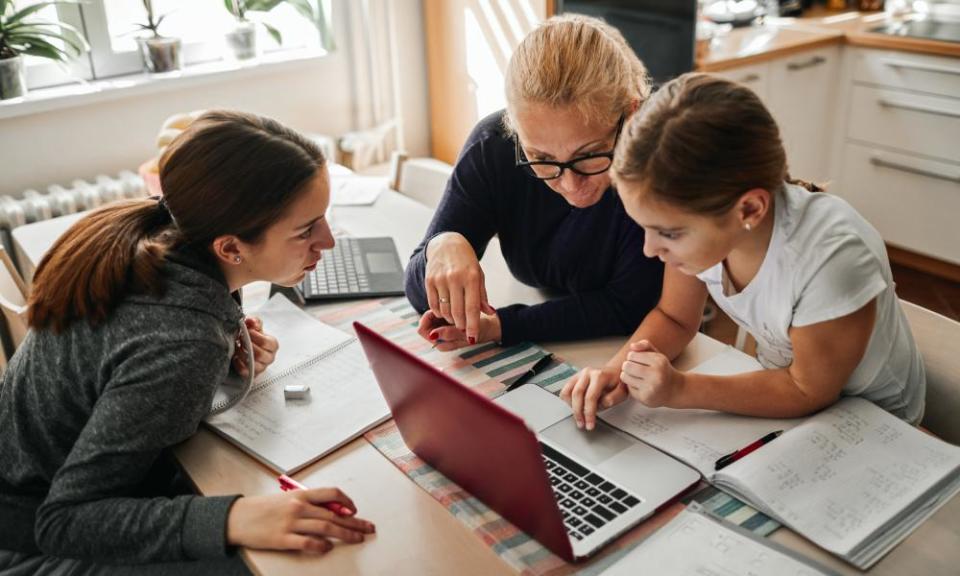UK home schooling numbers double in a week, amid Covid test shortages

The number of pupils in England who are studying remotely from home rather than in school has more than doubled in the space of a week, according to data shared exclusively with the Guardian.
Last week 12,000 pupils accessed lessons remotely as the new term got under way, but the number rose to 25,000 this week, according to the Oak National Academy, the online school set up by the government to support pupils in lockdown.
The sharp increase so early in the new term will ring alarm bells in government, as growing numbers of pupils and teachers are sent home to self-isolate amid a shortage of Covid-19 tests nationwide, and union leaders warn of a “lockdown by default”.
Related: England's schools 'will grind to a halt' unless Covid testing improves
In the first few days of the new school year alone, 2,000 schools accessed the Oak website and downloaded 20,000 resources to support pupils’ remote teaching, and isolating children confined to their homes accessed half a million online lessons.
Some secondary schools have already had to send multiple year groups home following advice from local public health authorities, while other schools are reporting that up to a fifth of their pupils are self-isolating at home, hindering their education and preventing some parents from working.
“We are really pleased with our site, but there is no substitute for being in a classroom with a teacher,” said Matt Hood, principal at the Oak academy and an independent adviser at the Department for Education.
With up to 25,000 teachers in England already forced out of the classroom and into self-isolation, Hood warned that some schools could have to close if teachers failed to get swift Covid-19 tests that would enable them to return to the classroom, resulting in even more children dependent on remote learning.
“If we can’t get adults back into schools as quickly as possible, it becomes at some point unsafe for the school to open,” said Hood. “The worst-case scenario is that we start to see schools close.”
Related: The school I run has lost five staff due to Covid test delays. This can't go on | Jules White
The Oak principal said teachers faced an even greater challenge this term than during lockdown, when almost all children’s learning had to be done from home. This term, teachers are having to teach simultaneously in two different settings to cater for pupils at home and those in the classroom.
And he raised concerns about the impact of the “digital divide” between students who have a laptop or tablet to access remote learning and those without, should home schooling continue to play a significant part in the school timetable.
“We have to be confident kids at home have a device that works and the necessary data. There’s no point having all these remote lessons if children don’t have the device to access them.”
The government’s announcement in April of a £100m scheme to provide free laptops and 4G wireless routers for vulnerable pupils with social workers, care leavers and disadvantaged year 10s was welcomed, but roll-out was slow and critics said the scheme was not nearly ambitious enough.
“This term is long and it’s hard,” said Hood. “Schools are doing a remarkable job under the circumstances. We are trying to do everything we can to help, but we’ve still got problems with the digital divide.” Ministers have promised to extend and expand the offer this term.
Related: Home schooling drove me to despair – but it also taught me a valuable lesson
Oak National Academy was set up in April as the pandemic took hold across Europe and schools were closed, to provide free online lessons and resources for pupils aged four to 16. In June it was awarded £4.34m to prepare for the next academic year, as part of the government’s contingency planning should schools remain closed.
Stephen Eastman, head teacher of Marine Park first school, in Whitley Bay, North Tyneside, is among those school leaders already using Oak material. He said a fifth of his pupils were working at home. “We did not envisage we would be at this position quite as quickly as this,” he said.
He said said several classes in his school were at home, as well as a small number of individual pupils from different classes who either have symptoms, or have family members with symptoms and awaiting tests.
“It’s just the uncertainty of where we are going next with this,” he said. “It feels a bit fluid in so many ways. We are having to be very flexible and reactive. All your plans have to be rethought. It’s really, really challenging.”

